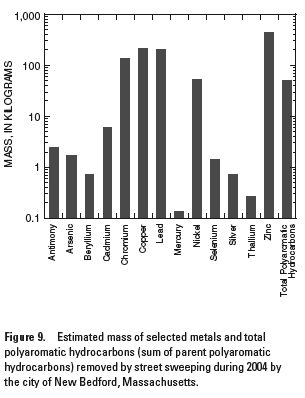Residential Street-Dirt Accumulation
Rates and Chemical Composition, and
Removal Efficiencies by Mechanical- and
Vacuum-Type Sweepers, New Bedford,
Massachusetts,
Study Conducted 2003 — 2004
By Robert F. Breault, Kirk P. Smith, and Jason R. Sorenson
In cooperation with the
U.S. Environmental Protection Agency,
Massachusetts Department of Environmental Protection, and the
City of New Bedford Department of Public Works
Scientific Investigations Report 2005-5184

Study Summary and Conclusions
Street-dirt-accumulation rates, street-dirt chemistry data, and street-sweeper efficiencies can be used to estimate the potential benefits gained by implementing a sweeping program.

Existing information about sweeper efficiencies comes either from studies done in the late 1970s and early 1980s that focus mainly on older brush-type street sweepers or from manufacturers' reports on newer types of sweepers. Similarly, data on street-dirt-accumulation rates and chemistry also come primarily from these earlier studies, which include few done in the northeastern United States.
Additional information on newer sweeping technologies and street-dirt-accumulation
rates and chemistry for cities in Massachusetts may aid managers in the northeastern United States in determining the effectiveness of street sweeping as a water-quality-management
tool.
To this end, the U.S. Geological Survey (USGS), in cooperation with the U.S. Environmental Protection Agency (USEPA), Massachusetts Department of Environmental Protection (MDEP), and the city of New Bedford Department of Public Works, undertook a study to evaluate street-dirtaccumulation
rates, its chemical composition, and street-sweeping efficiencies in 2003 and 2004.
Specifically, this study entailed three distinct field efforts: (1) measurement of street-dirt accumulation from two residential areas in the city of New Bedford, Massachusetts, after specific time intervals; (2) collection of street dirt for analysis of chemical composition
from these same two areas and from two street sweeper-types; and (3) controlled measurement of street-dirt removal efficiency for a Pelican Series P mechanical sweeper and a Johnston 605 series vacuum sweeper.

Although the study results are based on a limited number of samples, they provide useful information for city managers
and water-resource managers tasked with improving urban waterways. Street-dirt accumulation experiments were repeated twice at two different street locations. Street-dirt chemical composition was determined in a sample collected from the same streets used in the street-dirt accumulation experiment and in the samples of street dirt collected by each of the two sweepers.
Two controlled experiments of sweeper efficiency for each type of sweeper were also done. Other factors
to consider in a more detailed study would include seasonality,
temporal and spatial variability, and land use. It is important to note that the most important result of this preliminary study is the similarity observed between this study's data and those collected by others from across the Nation.
For example, average street-dirt-accumulation rates measured in this study (14 g/curb-m/d) are similar to those measured by others (9 to 15 g/curb-m/d); estimated total recoverable concentrations of arsenic (4 ppm), cadmium (0.9 ppm), chromium (261 ppm), copper (404 ppm), lead (335 ppm), nickel (31 ppm), and zinc (260 ppm) in street dirt collected in this study are for the most part similar to average concentrations of these contaminants measured by others; the average anthracene/anthracene plus phenanthrene PAH ratio of 0.16 calculated for street dirt collected from New Bedford is similar to the ratio of 0.18 calculated for street dirt collected by others; C0/C0+C1 (phenanthrene/anthracene) and C0/C0+C1 (fluoranthene/pyrene) ratios measured in this study (0.71 and 0.80) are similar to those measured by others (0.76 and 0.89); and the mechanical (20 to 31 percent) and vacuum (60 to 92 percent) sweeper efficiencies measured here are similar to the mechanical (10 to 30 percent) and vacuum (90 percent) sweeper efficiencies measured by others.
In addition, concentrations of trace elements and organic compounds measured in street dirt swept by the city of New Bedford may represent overall street-dirt chemistry for all land use areas within the city. The limited data collected indicate that, generally, trace element concentrations were lower than those measured in samples collected in the predominately multifamily land-use areas, whereas PAH concentrations were generally higher in the swept dirt.
Data collected in this study indicate that New Bedford's street-sweeping program has removed about 3.8 million kilograms of street dirt, which contains potentially toxic chemicals such as trace metals and PAHs that may have otherwise ended up in the city's catch basins, treatment plants, and rivers and streams that receive urban runoff.

This study was initially published online at:
http://pubs.usgs.gov/sir/2005/5184/
|